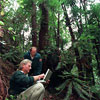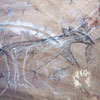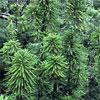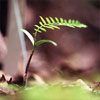
|
Previous issues
| Issue 8
| Issue 9
| Issue 10
| Issue 11
| Issue 12
| Issue 13
| Issue 14 |
Did you know?
.........................
The Wollemi Pine will be available for sale in 2005/6.
This date has been set to allow sufficient time for horticulturalists and scientists to research and cultivate the plant so as to secure the ongoing survival and conservation of this rare and threatened species.
As the 2005/6 public release of the Wollemi Pine in Australia and internationally is expected to generate widespread demand,
we encourage all potential buyers to register their interest by subscribing to the Wollemi Pine Conservation Club.
As a subscriber, you will receive Wollemi Watch - a quarterly e-newsletter covering the latest product information and research findings on the Wollemi Pine.
Closer to the release date of 2005/6, we will also provide you with details on how you will be able to purchase your own Wollemi Pine.
|
|
|
Welcome
to the second edition of Wollemi Watch, a quarterly online newsletter
for Wollemi Pine enthusiasts the world over.
This
edition commemorates Biodiversity Month and National Threatened
Species Day in Australia which aims to encourage community participation
in conservation activities and raise awareness about the plight
of threatened species such as the Wollemi Pine.
We hope you enjoy this next installment in the Wollemi Pine story
which highlights some of the latest scientific work to protect the
ecology of the wild Wollemi Pines, presents a news flash about 4000
year old Aboriginal rock art found near the wild Wollemi Pines,
reports on more FAQs from our Wollemi Pine Conservation Club, and
reveals other Jurassic plant species still growing today.
|
|

Threatened
Species Day Highlights the Wollemi as a Flagship Species
Australia's
National Threatened Species Day is held during Biodiversity Month
on September 7 every year to mark the day in 1936 when the last
known Tasmanian Tiger died in captivity. It aims to raise awareness
about the country’s threatened species and encourage all Australians
to prevent further extinctions of native fauna and flora. It is
also the perfect showcase for endangered plants like the Wollemi
Pine to act as flagship species to promote other rare and threatened
plants in urgent need of protection and conservation.
According to Fauna & Flora International, the world's longest established
international conservation organisation, flagship species are popular
and charismatic plants or animals which often have important cultural
associations. By protecting them, we are ensuring the survival of
other species that share the same habitat. Flagship species also
serve as symbols for the broader threat to the environment in which
they occur.
The Wollemi Pine is a natural flagship species. The remarkable story
of its discovery as a remnant species from the time of the dinosaurs
is an inspiring and a timely reminder that the need to conserve
and protect our fragile environment is paramount. The Wollemi Pine
also is endangered.
As an endemic species, meaning that it occurs in just one place
and nowhere else on earth, the Wollemi Pine is in the highest risk
category. There are less that 100 adult Wollemi Pines known to exist
in the wild and their habitat is very fragile having been undisturbed
for thousands of years. They exist in a microcosm of a past environment.
If this environment was destroyed, we would remove the clues as
to how the species has survived over 17 ice ages and many millions
of years.
Humans pose the greatest threat to the trees' survival. These threats
include inadvertent wildfires and the introduction of weeds and
plant disease. Just one unauthorised visit could be fatal if disease
is introduced to the fragile population. To guard against this,
the exact location of the wild population is a closely guarded secret
and posters have been placed in targeted venues in the Blue Mountains
region to warn bushwalkers of the dangers of attempting to visit
the Wollemi Pines in the wild.
A key strategy to conserve the Wollemi Pines in the wild has been
the decision to propagate the trees and make them available in Australia
and internationally by 2005/6. It is hoped that by giving people
the opportunity to have their own Wollemi Pine, it will reduce the
chance of them wanting to visit the wild population. The sale of
every Wollemi Pine will also return a royalty to fund the conservation
of the wild Wollemi Pines and other rare and threatened species.
As a flagship species, the Wollemi Pine is not only raising awareness
of other rare and threatened species but also generating funds for
their protection. For instance, funds from the sale of the Wollemi
Pine will also help save the Dwarf Mountain Pine or Microstrobos
fitzgeraldii. The Microstrobos, meaning 'mini pine cone',
clings between cracks high on the cliff faces of a number of the
big waterfalls in the Blue Mountains. Like the Wollemi Pine, it
lives nowhere else in the world but was once more widespread having
since been reduced to only six sites where it clings to life in
the waterfall's spray zone of south-facing slopes above 700 metres.
Its greatest threat is algae growth due to garden fertilisers that
are leaching into waterways.
National Threatened Species Day is a time to reflect on the value
of conservation programs like the Wollemi Pine and think about the
contribution you can make in your community to help protect your
local flora and fauna. If you would like to support the conservation
of the Wollemi Pine, acquiring a Wollemi Pine when they become available
in 2005/6, is one of the best ways. If you have not done so already,
you may wish to join the Wollemi Pine Conservation Club to register
your interest in purchasing a Wollemi Pine.
National Threatened Species Day was developed by the Threatened
Species Network, a community based program of the World Wide Fund
for Nature (WWF) and the Australian Commonwealth Government's Natural
Heritage Trust. Activities range from exhibitions and festivals,
to guided walks, and a range of other community education and promotional
activities.
For more information about Threatened Species Day activities in
your home country contact your local
WWF office.
For more information on Fauna
& Flora International.
Join
the Wollemi Pine Conservation Club and find out more about how to
purchase a Wollemi Pine when they become available in
2005/6
Take
a virtual tour to the wild Wollemi Pine population
|

Behind
the Scenes with John Benson
John
Benson is a Senior Ecologist at the Royal Botanic Gardens and Domain
Trust Sydney and has been involved in the research and protection
of the Wollemi Pine since its discovery in 1994. Prior to joining
the Royal Botanic Gardens in 1991, he was employed by the NSW National
Parks and Wildlife Service and has spent the last 28 years undertaking
ecological studies of many plant species and vegetation types, as
well as contributing to the formulation of environmental policies
and laws.
John is a member of the Wollemi Pine Recovery Team that was behind
the decision to commercialise the Wollemi Pine in order to prevent
intrusions into the wild population. He is also currently in the
process of writing the definitive papers on the ecology of the Wollemi
Pine that will document aspects of the wild populations such as
seedling growth rates and the size and numbers of existing trees.
“Our decision to commercialise the Wollemi Pine was influenced by
case studies in Australia where small populations of endangered
plant species were destroyed because the plant was not protected
adequately in the wild or made available commercially. This happened
to the Foxtail palm (Wodyetia bifurcata), in the state of Queensland,
where the wild populations were ravaged and a black market in the
sale of the palms was created internationally,” said John.
“Considering the excitement of the Wollemi Pine discovery, we felt
that if the species was not made available to the public, the wild
population would be at risk. The commercialisation project of the
Wollemi Pine is indeed a great success to date and we believe it
is one of the first attempts worldwide to commercialise an endangered
species in order to save it.”
John has pioneered the study of many threatened plant species including
the Grevillia beadleana and the Eucalyptus dumii.
His work has focussed on the development of computer database systems
on threatened species and contributing to the drafting of threatened
species conservation laws and policies. Some of his most challenging
work has involved the surveying of NSW forests to establish conservation
reserves and assisting in the complex policy formation process to
protect them.
He is also involved in the survey and mapping of various vegetation types having conducted some of the most detailed vegetation mapping done anywhere in Australia.
One current project in NSW is the development of a computer database to extensively classify plant communities and collate all previous studies into one system that can be used to assess the distribution,
threat status and protected area status of each plant community.
This will be used for planning and land management decision making across NSW.
John Benson has been published in the popular media on nature conservation
and sustainability as well as written over 120 papers and reports
on topics ranging from managing Australia's rangelands to the ecology
of endangered species. His report on the ecology of the wild Wollemi
Pine population is due to be released in approximately 12 months
and a summary of its findings will be published in the Wollemi Watch.
Stay tuned to hear more about people like John who are working to conserve and protect the Wollemi Pine for current and future generations to enjoy.
|

4000
Year Old Aboriginal Rock Art Uncovered in Wollemi Wilderness
In the Wollemi National Park, home of the Wollemi Pine, 4000 year
old rock paintings have just been uncovered marking the most significant
find of Aboriginal art in the state of New South Wales in half a
century. Hidden for generations by the Park's rugged and inhospitable
terrain, the drawings and stencils are thought to have been placed
on the walls of the remote cave at a time before China was a unified
empire, when civilisation in Egypt and Crete was well advanced,
and when Stonehenge was being built.
The discovery, which was announced on July 2, 2003, was made by
a team from the Australian Museum. Leading the find was the Australian
Museum's resident rock art specialist and Principal Research Scientist
in Anthropology, Dr Paul Taçon.
"It is like an ancient world that time forgot. We've never seen
anything quite like this combination of rare representations in
so many layers. The drawings are dominated by a range of birds,
lizards and marsupials. There are life-size delicately drawn eagles,
kangaroos and an extremely rare depiction of a wombat. Stencils
include hands, boomerangs and axes. The 203 depictions are composed
of 12 layers built up over time in various colours such as red,
yellow, white and charcoal," said Dr Taçon.
"We are incredibly excited about what the cave has revealed to us
of the long record of visitors to the area. It is amazing to contemplate
why people repeatedly travelled great distances through such a rugged
landscape to leave their marks on this cave time and again."
"This find and the discovery of the Wollemi Pine show how valuable
our wild places are. They can tell us about the world of plants
and animals, in the past and in the present, and how people have
had a relationship with these places for tens of thousands of years.
It is likely that there were powerful spiritual beliefs associated
with this remarkable site," said Dr Taçon.
The National Parks and Wildlife Service have chosen to restrict
information about the exact location of the site in order to protect
it from inadvertent or wilful damage. The decision has the support
of local Aboriginal people. However, more details on the find will
soon be made available to the public on
the Australian Museum's web site, via scientific journals
and a documentary that will be released next year.
|

Wollemi
Pine Conservation Club – FAQs
Wollemi
Pine enthusiasts worldwide have been signing up to the Wollemi Pine
Conservation Club to register their interest in acquiring a Wollemi
Pine. Here are just a few of the recent enquiries which illustrate
the excitement that educators, home gardeners, and botanists alike
share for this remarkable species.
I am wondering if the Wollemi Pine will grow close to the ocean.
Certain plants do not grow here because of too much salt in the
air. The ocean is only about 1/2 kilometer away in two directions.
Home Gardener, California, USA
We are in the process of setting up trials in a variety of plant
hardiness zones across the United States so we can inform people
as to how the Wollemi Pine will perform outside in locations such
as on the coast in California. So far it seems that the Wollemi
Pine is a very hardy plant. Its strong bark and waxy leaves help
it to survive most temperatures from 0-45 °C, even down to -5 °C
for a short period of time. The fact that it has survived all these
millions of years through global warming and cooling suggest that
it may be a very versatile plant and can survive a broad range of
climatic conditions. We will be releasing further information on
our trialing in the US over the next few years and encourage you
to stay tuned. Please consider that the Wollemi Pine also makes
a great indoor plant too.
As a teacher at a local school I would like to know how we could
register for buying some Wollemi pines for our environmental club.
Our school is registered with the local Council as a Land Care environmental
protected area and we very much support the protection of endangered
species. I would appreciate information of how to obtain seedlings
on release.
Teacher, QLD, Australia
The Wollemi Pine story is great educational material and the
perfect gift for your school environmental club. We have many enquiries
from teachers and are currently investigating ways to make Wollemi
Pines available for sale to schools as part of a special Wollemi
Pine schools kit when they become available in 2005/6. We will release
details of how to order your Wollemi Pine closer to 2005/6. At this
stage, Wollemi Pines will be available through carefully selected
retail partners as well as available online at www.wollemipine.com.
It is important to note that every Wollemi Pine sold will return
royalties to the Royal Botanic Gardens and NSW National Parks and
Wildlife Service. These royalties will be used to support the ongoing
protection of the Wollemi Pine and other rare and threatened species
in the Blue Mountains area such as the Dwarf Mountain Plum Pine
(Microstrobus fiztgeraldii), the Brush-tailed Rock-wallaby, and
the Koala.
I will move to Southern Sweden next year and am making an open park.
I wonder if the Wollemi might survive - 2°C in winter or would need
to be placed inside in a tropical garden?
Home Gardener, Sweden
Testing in Australia has indicated that the Wollemi Pine will
survive temperatures as low as -2°C. However, further testing is
required to determine whether it will withstand such cold temperatures
for extended periods of time. We will be releasing further information
on the hardiness of the Wollemi Pine over the next few years and
encourage you to stay tuned. As you suggested, the Wollemi Pine
also makes a great indoor plant as it responds well to low light.
Thank you for your inquiry and we look forward to keeping you updated
on the progress of the Wollemi Pine in cultivation.
See
more frequently asked questions
Joining
the Wollemi Pine Conservation Club registers your interest
in purchasing a Wollemi Pine when they are released in 2005/6.
|

Fact
File: What other Jurassic plants are still alive today?
The Dawn Redwood, the Ginkgo and Cycads are examples of other remnant
plant species like the Wollemi Pine that have survived since the
age of dinosaurs. What is remarkable about the Wollemi Pine is that
it is a completely new genus that has remained unchanged for millions
of years until it was recently found growing on the doorstep of
a city of 4 million people - Sydney. Here's some background on these
species:
Dawn Redwood or Metasequoia glyptostroboides is a
deciduous conifer known from fossils and assumed long-extinct before
it was discovered growing in the wild in China in the 1940s. It
had actually been in China since the time of the dinosaurs. It is
a fast grower, eventually attaining 60 metres (200 feet), and it
has attractive, lacy needles.
Ginkgo biloba or maidenhair tree is a beautiful tree with
intriguing fan-shaped leaves. It was discovered in China in 1690
but now has very restricted natural distribution. In cultivation
it has been used as a popular city tree due to it being able to
tolerate dust and pollution. Medicinal extracts made from the dried
leaves have been used for centuries in traditional Chinese medicine.
Cycads are an ancient group of seed plants with a crown of
large compound leaves and a stout trunk. They are a minor component
of the flora in tropical and subtropical regions today, but during
the Jurassic Period, they were a common sight in many parts of the
world. For this reason, the Jurassic period is often referred to
as the "Age of Cycads". See the Royal
Botanic Gardens web site on cycads for further information.
Please email us at
info@wollemipine.com
to tell us about other trees/plants that you think can be likened
to the Wollemi Pine in terms of their ancient heritage and/or amazing
story of discovery.
Want
to experience the Wollemi Wilderness? Download
your own Wollemi wallpaper >> Click
Here
|
|
| Photos:
Jaime Plaza (Botanic Gardens Trust) and Blue Mountains Tourism |
|
|

|


